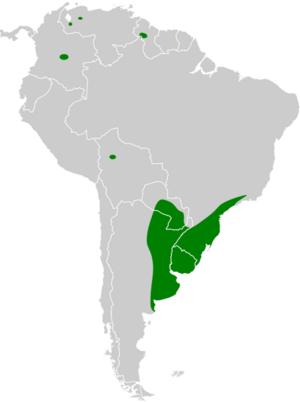Speckled rail facts for kids
Quick facts for kids Speckled rail |
|
|---|---|
 |
|
| Conservation status | |
| Scientific classification | |
| Genus: |
Coturnicops
|
| Species: |
notatus
|
 |
|
The speckled rail (Coturnicops notatus) is a small and secretive bird. It is also known as the speckled crake. This bird belongs to the Rallidae family, which includes rails, gallinules, and coots. You can find speckled rails in several South American countries. These include Argentina, Brazil, Guyana, Paraguay, Uruguay, and Venezuela.
Contents
About the Speckled Rail's Family
The speckled rail is part of a group of birds called Coturnicops. This group also includes two other interesting rails. One is the yellow rail (C. noveboracensis), found in North America. The other is Swinhoe's rail (C. exquisitus), which lives in eastern Asia. The speckled rail is a unique species, meaning it does not have different subspecies.
What Does a Speckled Rail Look Like?
The speckled rail is a small bird, about 13 to 14 centimeters (5 to 5.5 inches) long. It weighs around 30 grams (1 ounce), which is about the same as a few quarters. Male and female speckled rails look very similar. Their feathers are a very dark brown color. They have small white spots on their backs and wings. Their undersides have white bars, like stripes.
Where Speckled Rails Live
The main places where speckled rails live are southern Paraguay, southern Brazil, eastern Argentina, and Uruguay. They are also found in Guyana and Venezuela. Sometimes, a speckled rail might wander to other places, like Colombia. This is called being a vagrant. Some people have reported seeing them in Bolivia and the Falkland Islands. However, these sightings are not fully confirmed yet.
Speckled Rail Habitats
Speckled rails prefer to live in wet, grassy areas. They like dense marshes, swamps, and grassy savannas. You might also find them in fields where rice or alfalfa are grown. They can live from sea level up to about 1,500 meters (4,900 feet) high.
Speckled Rail Behavior
How Speckled Rails Move Around
Some experts think that speckled rails might migrate. This means they would move from the south to the north for winter. However, many speckled rails have been seen in Brazil, Paraguay, and Uruguay during the southern winter. Also, birds ready to breed have been found in Venezuela. This suggests they might not always migrate.
What Speckled Rails Eat
We don't know much about how speckled rails find their food. We also don't know a lot about their diet. But we do know they eat grass seeds. They also eat small arthropods, which are creatures like insects and spiders.
Speckled Rail Reproduction
The breeding season for speckled rails is mostly a mystery. In the southern parts of their range, they seem to breed around December. In Venezuela, they might breed in August. Scientists are still learning about how these birds raise their young.
Speckled Rail Sounds
It's very rare to hear a speckled rail. As of late 2022, there were almost no recordings of their calls. They have a call that sounds like "kooweee-cack." They also make a whistling "keeee" sound when they are alarmed. Another sound they make is a high "kyu," but we don't know why they make this sound.
Speckled Rail Status
The IUCN (International Union for Conservation of Nature) has looked at the speckled rail. They have listed it as a species of "Least Concern." This means they are not currently in danger of disappearing. However, we don't know exactly how many speckled rails there are. Their numbers are thought to be slowly going down. No major threats to the species have been found yet. It's hard to find these birds, so they are thought to be genuinely rare.


